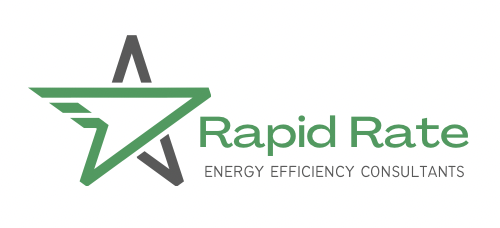Our services
Welcome to Rapid Rate, where we specialise in providing NatHERS energy efficiency ratings. Our team of experts has years of experience in conducting energy assessments and helping our clients make informed decisions that can save them money and reduce their environmental impact.
NatHERS (Nationwide House Energy Rating Scheme) is an initiative of the Australian government that rates the energy efficiency of residential buildings. By getting a NatHERS rating, homeowners can determine how energy-efficient their homes are and identify areas for improvement.
At Rapid Rate, we offer a range of services to help our clients achieve their energy efficiency goals. Our experienced assessors will conduct a thorough evaluation of your home, taking into account factors such as insulation, window orientation, and building materials. We use the latest software tools to provide a detailed report that outlines your home's energy efficiency rating and recommends improvements that can save you money on your energy bills.
We also provide advice on sustainable building materials and construction techniques that can help you achieve a higher NatHERS rating. Whether you're building a new home or renovating an existing one, our team can help you make informed decisions that will improve your home's energy efficiency and reduce your environmental impact.
Our commitment to providing accurate and reliable NatHERS ratings has made us one of the most trusted energy assessment companies in the industry. We pride ourselves on our professionalism, attention to detail, and dedication to providing our clients with exceptional service.
If you're looking to improve the energy efficiency of your home, contact us today to schedule a NatHERS assessment. Our team of experts is ready to help you make your home more comfortable, sustainable, and energy-efficient.
NatHERS Reports
We specialise in providing NatHERS 6-Star reports (and soon to be 7-Star and Whole of Home!) for new builds. As part of the Australian government's nationwide energy efficiency initiative, new homes are required to achieve a minimum 6-Star NatHERS rating. After the 1st May 2024, this increases to 7 stars with an additional Whole of Home assessment. Our team of expert assessors is here to help you achieve this rating and ensure that your new home is as energy-efficient as possible.
NatHERS Report for Addition/Alterations
The Two House Energy Rating Method is an essential approach for achieving compliance with Part EE-04 of the Victorian Building Authority (VBA) regulations. This method involves an in-depth assessment of the existing dwelling (as it currently stands), and the proposed dwelling (including remaining existing portions). Through first analysing the existing dwelling, and completing calculations to understand the total volume of the alterations and additions, we can then ascertain the required rating for the proposed design. The proposed works are benchmarked at 6 Star compliance, but are mitigated throughout the areas of the existing that are not practicable to upgrade.
BASIX Report
BASIX stands for Building Sustainability Index, and it is a sustainability assessment tool that aims to reduce water and energy consumption in new residential developments.
All new developments in NSW, including alterations and additions to existing buildings, must comply with BASIX requirements. The BASIX assessment measures the sustainability of a building design based on factors such as energy efficiency, water usage, and thermal performance.
Section J Deemed-to-Satisfy
The purpose of Section J is to ensure that buildings are designed and constructed in a way that achieves adequate levels of energy efficiency. This section is particularly focused on the building's thermal performance, glazing, insulation, air-conditioning systems, lighting, and other key elements that influence a building’s energy consumption.
The DtS provisions provide a prescriptive pathway to comply with the energy efficiency requirements of the NCC. Instead of proving compliance through complex energy modelling (performance-based solution), builders and designers can follow the DtS provisions, which list specific measures that must be incorporated into the building design. If these measures are followed, the building is deemed to satisfy the requirements of Section J.
Key components covered in a DtS report include:
- Building Fabric – Insulation levels, thermal breaks, and glazing.
- Glazing – Window types, shading, and orientation considerations.
- Building Sealing – Measures to prevent air leakage.
- Air Conditioning and Ventilation Systems – Energy efficiency of HVAC systems.
- Lighting – Efficiency of lighting systems, lighting controls, and their operation.
- Hot Water Systems – Ensuring water heating is energy-efficient.
- Access for Maintenance – Ensuring systems can be maintained to operate efficiently over time.
JV3 Reports
A JV3 Report involves a detailed energy modelling process where a building's design is compared to a reference building that follows the Deemed-to-Satisfy (DtS) provisions of Section J. The energy consumption of the proposed building is simulated and must demonstrate equal or better performance than the DtS-compliant reference building.
Key elements included in the JV3 Report:
- Energy Modelling: The proposed design is modeled using specialized software to simulate its energy usage, considering factors like heating, cooling, ventilation, lighting, and building services.
- Reference Building: A comparative analysis is made with a reference building designed according to the DtS provisions. The goal is to prove that the proposed building performs as well or better in terms of overall energy efficiency.
- Thermal Performance: The report evaluates the building’s thermal envelope (insulation, glazing, air sealing) and how it impacts the heating and cooling loads.
- Building Services: It also takes into account the efficiency of the HVAC systems, lighting systems, and other energy-consuming services.
- Flexibility in Design: This performance-based approach allows for more flexibility in the design process, allowing architects and engineers to pursue innovative designs that don’t strictly adhere to the DtS requirements but still achieve energy efficiency.
Interested in our services? We’re here to help!
We want to know your needs exactly so that we can provide the perfect solution. Let us know the details of your project and we'll find the most efficient, cost-effective solution for your needs!

